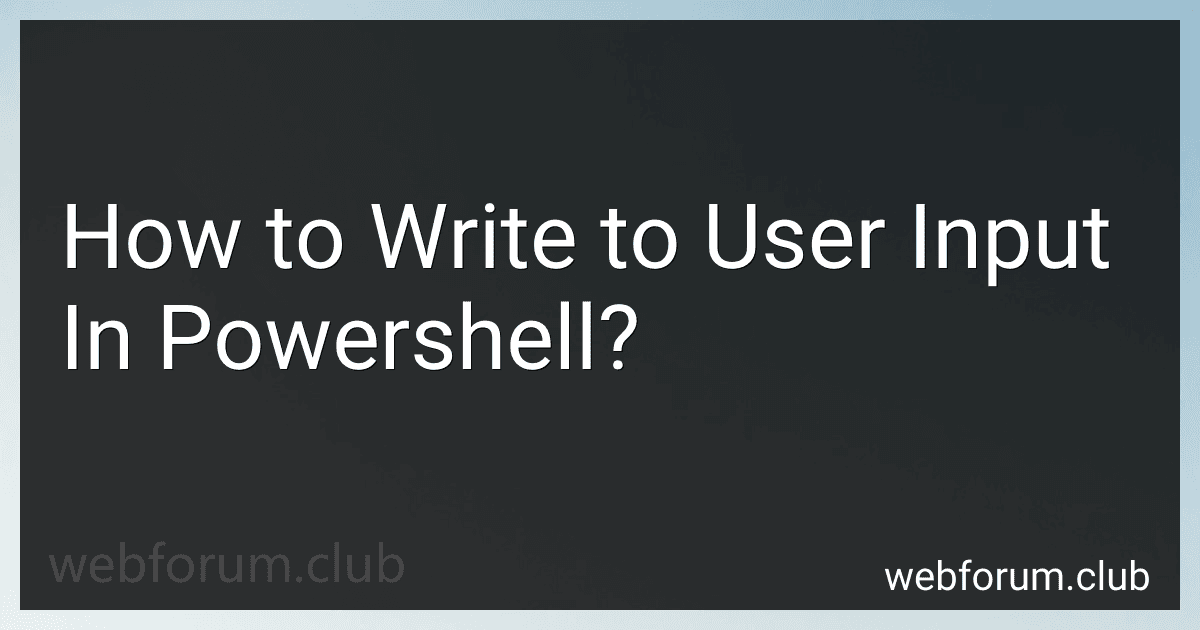To write to user input in PowerShell, you can use the Read-Host cmdlet to prompt the user for input and store the result in a variable. You can then use the Write-Output cmdlet to display the input provided by the user. This allows you to interact with users and gather information dynamically during the execution of your script. Additionally, you can use the Write-Host cmdlet to display a message to the user without storing it in a variable. Overall, by leveraging these cmdlets, you can easily write to user input in PowerShell scripts for enhanced user interaction and functionality.
How to securely handle sensitive data input from users in PowerShell?
- Use secure string for passwords: When prompting users for sensitive data such as passwords, use the Read-Host cmdlet with the -AsSecureString parameter to securely capture and store the input.
- Encrypt sensitive data: If you need to store sensitive data in a file or database, consider encrypting the data using encryption algorithms such as AES before saving it.
- Avoid logging sensitive data: Be mindful of not logging any sensitive information, such as passwords or personal identification details, in your scripts or logs.
- Validate input: It's important to validate any user input to ensure it meets the expected format and length requirements before processing it further.
- Limit access to sensitive data: Restrict access to scripts or systems handling sensitive data to only authorized personnel. Implement proper authentication and authorization mechanisms to control access.
- Secure communication: If sending sensitive data over a network, ensure that the communication is encrypted using secure protocols like HTTPS.
- Stay updated: Keep your PowerShell environment and modules up to date to address any security vulnerabilities that may exist in older versions.
- Implement error handling: Proper error handling can help prevent sensitive data from being inadvertently exposed in error messages. Only display generic error messages to users and log detailed error information for troubleshooting purposes instead.
How to display user input in PowerShell?
To display user input in PowerShell, you can use the Read-Host cmdlet to prompt the user for input and store the input in a variable. You can then use Write-Host or simply output the variable to display the user input.
Here's an example:
$userInput = Read-Host "Enter your name" Write-Host "You entered: $userInput"
When you run this script, it will prompt the user to enter their name. Once the user enters their name, it will display "You entered: [user's input]".
How to convert user input to different data types in PowerShell?
To convert user input to different data types in PowerShell, you can use type casting or data conversion functions. Here are a few examples:
- Convert a user input string to an integer:
$userInput = Read-Host "Enter a number" $number = [int]$userInput
- Convert a user input string to a double:
$userInput = Read-Host "Enter a number" $number = [double]$userInput
- Convert a user input string to a boolean:
$userInput = Read-Host "Enter true or false" $boolean = [bool]$userInput
- Convert a user input string to a date:
$userInput = Read-Host "Enter a date (mm/dd/yyyy)" $date = [datetime]::ParseExact($userInput, "MM/dd/yyyy", $null)
- Convert a user input string to an array:
$userInput = Read-Host "Enter a list of items separated by commas" $items = $userInput -split ","
These are just a few examples of how you can convert user input to different data types in PowerShell. Depending on your specific requirements, you may need to use different methods or functions for type conversion.
How to manipulate user input in PowerShell?
To manipulate user input in PowerShell, you can use a combination of input validation techniques and string manipulation functions. Here are some common ways to manipulate user input in PowerShell:
- Prompt for user input: Use the Read-Host cmdlet to prompt the user for input. You can specify a prompt message to guide the user on what type of input is expected.
$userInput = Read-Host "Enter a value:"
- Validate user input: Use conditional statements like if-else or switch to validate the user input. You can check if the input meets certain criteria, such as being a number or within a specific range.
if ($userInput -match '\d+') { Write-Host "Input is a number" } else { Write-Host "Input is not a number" }
- Convert input data type: Use type casting functions like [int], [double], or [datetime] to convert user input to a specific data type for further manipulation.
$intValue = [int]$userInput
- Manipulate strings: Use string manipulation functions like -replace, -split, or -join to modify the user input based on your requirements.
$newString = $userInput -replace 'oldvalue', 'newvalue'
- Format output: Use formatting commands like Format-Table or Format-List to present the manipulated user input in a structured way.
$userInput | Format-Table
By combining these techniques, you can effectively manipulate user input in PowerShell to suit your script's needs. Remember to always handle user input carefully to avoid security risks like injection attacks.
How to handle empty user input in PowerShell?
One way to handle empty user input in PowerShell is to check if the input is empty using an If statement or the -eq (equals) comparison operator. You can then prompt the user to enter a valid input or take alternative action if the input is empty.
Here is an example code snippet:
$userInput = Read-Host "Enter your input"
if ($userInput -eq "") { Write-Host "Input cannot be empty. Please enter a valid input." # Prompt user to enter input or take alternative action } else { # Continue with the rest of the script }
You can customize the message displayed to the user and the actions to be taken based on your specific requirements.
